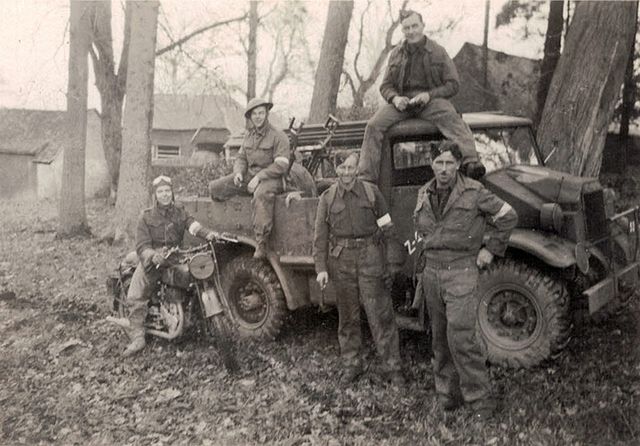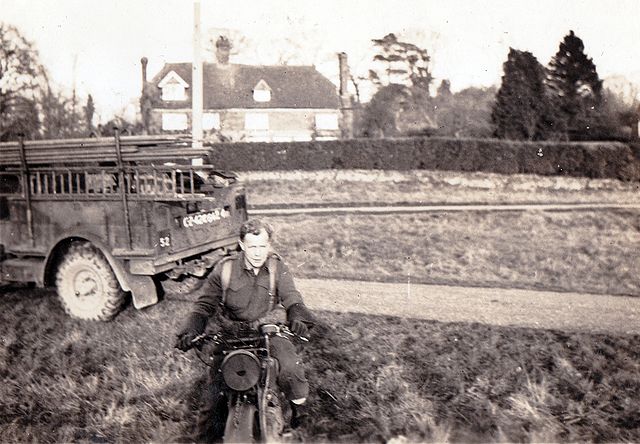
 |
|
#1
|
||||
|
||||
|
Hi all!
In my pursuit of info on all the specialty vehicles used by Canadian Signals, I've come across photos of what I believe is a 15-cwt GS Cable Layer. Photos are taken in the UK, probably late 1940, by a member of 2 Canadian Divisional Signals. I really don't have any info on this type of vehicle and am looking for assistance. the photos appear to be the early Cab-11 2A1 body type but I can't tell if it's just a GS being used as a cable layer or is it the official cable layer variant. Anyone know what they looked like? Any additional photos of them in Canadian service? http://www.rcsigs.ca/index.php/CMP_T...GS_Cable_Layer  
Last edited by Joe C; 04-12-17 at 03:26. Reason: Added photos |
|
#2
|
||||
|
||||
|
No information on this type of CMP?
|
|
#3
|
||||
|
||||
|
Here's one. It's the same as the one in your first picture.
__________________
1940 Cab 11 C8 Wireless with 1A2 box & 11 set 1940 Cab 11 C8 cab and chassis 1940 Cab 11 C15 with 2A1 & Motley mount & Lewis gun 1940 Cab 11 F15A w/ Chev rear ends 1941 Cab 12 F15A 1942-44 Cab 13 F15A x 5 1942 cab 13 F15A with 2B1 box 1943 cab 13 F15A with 2H1 box 1943 Cab 13 C8A HUP 1944 Cab 13 C15A with 2C1 box 1943 Cletrac M2 High Speed Tractor MkII Bren gun carrier chassis x 2 |
|
#4
|
||||
|
||||
|
Thanks David. Is there a reference number for the photo?
Are there any manuals that would deal with this variant? |
|
#5
|
||||
|
||||
|
Check out this link for more info. All the 2A1 boxes were the same. The cable layer just had different equipment in the back.
__________________
1940 Cab 11 C8 Wireless with 1A2 box & 11 set 1940 Cab 11 C8 cab and chassis 1940 Cab 11 C15 with 2A1 & Motley mount & Lewis gun 1940 Cab 11 F15A w/ Chev rear ends 1941 Cab 12 F15A 1942-44 Cab 13 F15A x 5 1942 cab 13 F15A with 2B1 box 1943 cab 13 F15A with 2H1 box 1943 Cab 13 C8A HUP 1944 Cab 13 C15A with 2C1 box 1943 Cletrac M2 High Speed Tractor MkII Bren gun carrier chassis x 2 |
|
#6
|
||||
|
||||
|
Thanks! Interesting thread and thanks for your assistance.
I'd love to know what equipment would have been in the box so I'll keep searching. |
|
#7
|
|||
|
|||
|
Quote:
The manual cable layer (which I think is the one in the photograph because that has a Barrows, Drum, Mk.4 (or similar) visible) which can be used in the vehicle (I think) or lifted out and operated on foot by the line party. The mechanical cable layer. (At least one of these was engine-driven and propelled the cable out of the side of the vehicle, controlled by the operator using a foot pedal (and, I assume, a hand throttle for the petrol engine that powered it). This was intended for rapid line-laying along roads, either feeding the cable into hedges/ditches, or into the street gutter in towns/cities where the line party would tie the cable off to drain gratings as it was being laid. I suspect that all the information you need is in Signal Training Volume IV for the appropriate era, either the 1927 edition or the 1941 reprint and the pamphleted add-ons to that. Another possible document for the actual use of the kit is the London Division Signals (TA) training manual from 1939. (Only look at the Indian version of Volume IV if you intend laying cable from an elephant.  ) )The photograph shows a line party equipped for 'Poled Cable', and looking at the picture I suspect they're reeling-in an existing line for re-use elsewhere. (I can't see any other reason for so many of them holding poles and someone operating the drum barrow. Unless the whole thing is posed, of course.) The truck has a ladder rack and storage for the standard 18-ft two-piece poles for overhead line and road crossings. Other kit would be a sledge hammer and 'jumper' (a pointed steel bar used for making holes to stick the poles in), picks and shovels for buried crossings, and the usual cable jointing tools and supplies. Everyone has a lineman's belt with a swivel loop to hold a clasp knife and a belt frog with a pair of of pliers in it. (The knife for cutting spun-yarn to use for tie-backs and for removing cable insulation and scraping the wires clean, and the pliers for cutting cable and twisting the joints on thicker cable, etc.) Chris. Last edited by Chris Suslowicz; 09-12-17 at 10:30. Reason: Layout |
|
#8
|
|||
|
|||
|
Good eye, Chris.
If one assumes the truck always points in the direction of work flow, a reeling in looks to be the task for the day. The cable appears to be on the ground ahead of the truck, and headed up to the mid rightside of the box to the cable reel. Unless the objective for the day was to lay the cable backwards... David |
|
#9
|
||||
|
||||
|
Much thanks Chris. I'll check out the sources you've suggested.
|
|
#10
|
|||
|
|||
|
Quote:
Thanks Pete |
|
#11
|
|||
|
|||
|
Chris S. What would you know about a pole (poles?) carried on an AOP Carrier?
The carrier has brackets (I have the remains of one) on the side for a short wooden extension ladder and there is a pole (I assume) for doing something with telephone wires. The Dagenham production book shows the pole but only enough to make out that that is what it is. I wondered if you might be able to fill in some details about it. Then I can stop side tracking this thread. The hole in the bracket is an elongated round hole 21 x 34mm.
__________________
Bluebell Carrier Armoured O.P. No1 Mk3 W. T84991 Carrier Bren No2.Mk.I. NewZealand Railways. NZR.6. Dodge WC55. 37mm Gun Motor Carriage M6 Jeep Mb #135668 So many questions.... |
|
#12
|
|||
|
|||
|
Quote:
 Chris. |
|
#13
|
|||
|
|||
|
Thank you Chris. Screw together makes sense otherwise (I thought) it would be too short. I was earlier assuming the use of telephone poles, but common sense negates them. You earlier post helped a lot.
Back to the thread...
__________________
Bluebell Carrier Armoured O.P. No1 Mk3 W. T84991 Carrier Bren No2.Mk.I. NewZealand Railways. NZR.6. Dodge WC55. 37mm Gun Motor Carriage M6 Jeep Mb #135668 So many questions.... |
|
#14
|
||||
|
||||
|
I believe these are he lineman poles you have been talking about. I picked them up off of eBay UK the other year. Each pole section is about 36" long. They all screw together.
__________________
Jordan Baker RHLI Museum, Otter LRC C15A-Wire3, 1944 Willys MB, 1942 10cwt Canadian trailer |
|
#15
|
|||
|
|||
|
Very good Jordan. Thanks for the pictures. That helps a lot! Now to swipe your pictures....
__________________
Bluebell Carrier Armoured O.P. No1 Mk3 W. T84991 Carrier Bren No2.Mk.I. NewZealand Railways. NZR.6. Dodge WC55. 37mm Gun Motor Carriage M6 Jeep Mb #135668 So many questions.... |
 |
|
|
 Similar Threads
Similar Threads
|
||||
| Thread | Thread Starter | Forum | Replies | Last Post |
| 19 Set Cable | Neil Ashley | The Wireless Forum | 4 | 29-03-17 06:59 |
| For Sale: KY-57 cable kit | karl_m38a1 | For Sale Or Wanted | 1 | 26-05-14 08:52 |
| Sold: Bombardier Iltis Cable Layer in CDN | super dave | For Sale Or Wanted | 4 | 10-04-13 06:20 |
| Restored Iltis Cable Layer Unit | super dave | Post-war Military Vehicles | 12 | 25-02-10 06:47 |
| Carrier speedo cable and choke cable. | kevin powles | The Carrier Forum | 1 | 15-11-08 03:18 |